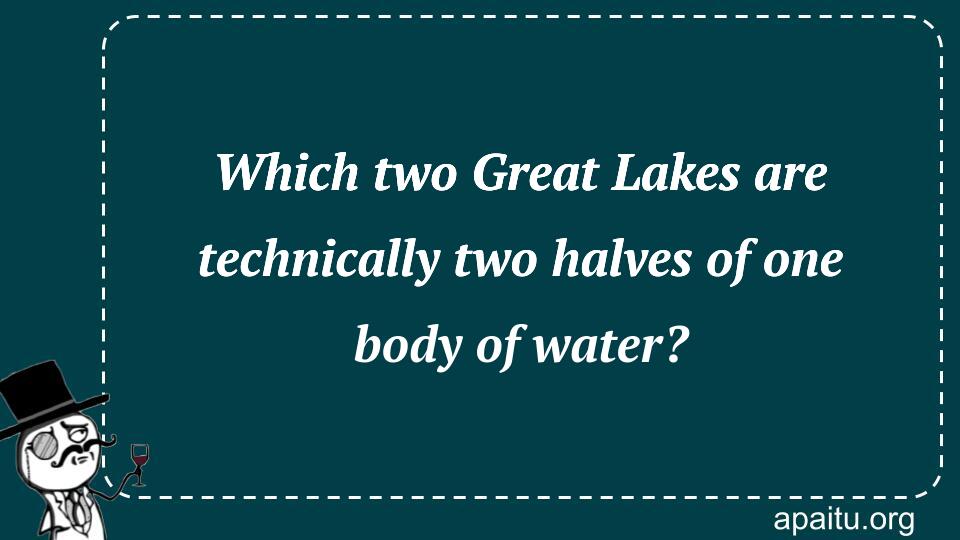Question
Here is the question : WHICH TWO GREAT LAKES ARE TECHNICALLY TWO HALVES OF ONE BODY OF WATER?
Option
Here is the option for the question :
- Superior and Michigan
- Michigan and Huron
- Huron and Erie
- Erie and Superior
The Answer:
And, the answer for the the question is :
Explanation:
The combined area of the five Great Lakes—Superior, Huron, Michigan, Ontario, and Erie—is more than 95,000 square miles. However, two of those five well-known lakes are actually one enormous lake from a hydrological perspective. The five-mile-wide Straits of Mackinac, which connects Lake Huron and Lake Michigan and keeps the water levels of both lakes at the same level, permits the two lakes to be regarded as a one continuous lake.

The Great Lakes, a magnificent system of interconnected freshwater bodies, hold many fascinating secrets and unique characteristics. Among these is the intriguing fact that two of the Great Lakes, Michigan and Huron, are technically two halves of one body of water. Today, we explore the geological and hydrological aspects that make Michigan and Huron an interconnected entity, despite being referred to as separate lakes.
Michigan and Huron are often described as twin lakes due to their similar water levels, shared shoreline, and hydrological connection. They are connected by the Straits of Mackinac, a narrow waterway that separates the two bodies of water while allowing for the exchange of water between them. This connection is a result of the geological history and formation of the Great Lakes region.
During the last ice age, massive glaciers sculpted the landscape, creating vast basins that would eventually become the Great Lakes. As the glaciers receded, they left behind deep channels and depressions, which became the foundations for the lakes. The land bridge that once separated the basins of Michigan and Huron eroded away, allowing water to flow freely between them.
While Michigan and Huron are technically considered separate lakes, they are part of the same hydrological system known as Lake Michigan-Huron. This system is the largest freshwater lake by surface area in the world, encompassing approximately 45,300 square miles (117,000 square kilometers). The shared water levels and the ability for water to flow between the two lakes mean that they essentially function as one interconnected body of water.
The hydrological connection between Michigan and Huron has several implications. Firstly, it affects the water levels in both lakes. Changes in precipitation, evaporation rates, and water flow through connecting channels can cause fluctuations in water levels. This interconnectedness also impacts the ecological balance and biodiversity of the region, as species move between the two lakes and rely on the shared resources.
The Straits of Mackinac, the narrow passage that joins Michigan and Huron, have played a significant role in the history and development of the Great Lakes region. This strategic waterway has been utilized for trade, transportation, and cultural exchange for centuries. It serves as a vital link between the Upper and Lower Peninsulas of Michigan and continues to be an important navigational route for ships and vessels.
It is important to note that while Michigan and Huron are interconnected, they still have distinct characteristics and features. Each lake has its own unique ecosystem, shoreline, and recreational opportunities. Michigan, for example, is known for its picturesque coastal dunes, while Huron boasts stunning limestone formations and scenic islands. Exploring both lakes provides a diverse and enriching experience for visitors and locals alike.
Michigan and Huron, two of the Great Lakes, are technically two halves of one body of water. Despite being referred to as separate lakes, they are interconnected through the Straits of Mackinac and function as a hydrological system known as Lake Michigan-Huron. This unique geological and hydrological connection adds to the allure and significance of the Great Lakes region. Whether you’re marveling at the sandy beaches of Michigan or exploring the rugged beauty of Huron, both lakes offer a wealth of natural wonders to discover and cherish.